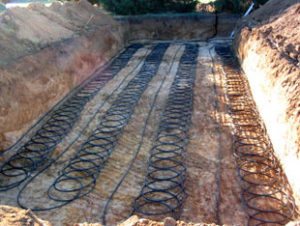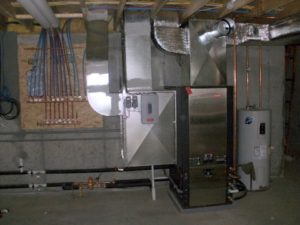 Geothermal is one of the most intriguing renewable energy options available. Once installed, most homeowners enjoy minimal costs for electricity to operate the system, and enjoy the notion that their carbon footprint is reduced considerably. We received an inquiry from a reader who was considering geothermal for her new Katahdin Cedar Log Home and we wanted to update her on how it works and when it makes sense.
Geothermal is one of the most intriguing renewable energy options available. Once installed, most homeowners enjoy minimal costs for electricity to operate the system, and enjoy the notion that their carbon footprint is reduced considerably. We received an inquiry from a reader who was considering geothermal for her new Katahdin Cedar Log Home and we wanted to update her on how it works and when it makes sense.
How Does Geothermal Work?
Geothermal energy is the natural warmth found in soil everywhere. If you’ve ever explored a deep cave you know that the deeper you go, the warmer it becomes! Geothermal systems transfer energy from the ground to energize a ground-source heat pump inside the home.
To understand how geothermal heating and cooling works, it helps to compare with a more familiar system. Traditional HVAC systems burn a fuel to create heat or use a large amount of electricity to energize a heating element to create heat. On the other hand, heat pump-based systems transfer energy from one place to another. Geothermal systems transfer the natural warmth in the earth to a heat pump. In the winter, a heat pump transfers energy into the home for warmth. In the summer, the energy is used to extract heat from the home, keeping it cool and comfortable.
 How is Geothermal Energy Transferred?
How is Geothermal Energy Transferred?
Geothermal systems use a ground source heat pump as the converting appliance. The energy from the ground is collected by circulating water or an antifreeze solution through loops of tubing. The loops are laid out in trenches at a certain depth, then covered with soil. Once in the ground, the fluid in the loops is naturally heated to a consistent temperature, usually around 50 degrees. No matter how cold or hot the weather is above ground, below ground that temperature remains the same. The warmed fluids are pumped into the home where the energy is extracted by the heat pump, then circulated back into the ground loop to be heated again.
Why are Geothermal Systems So Efficient?
Geothermal’s super-efficient results come from the relatively small amount of electricity needed to pump the fluids through the underground loops and then extract the transferred energy to heat or cool the home.
When Does Geothermal Make the Most Sense?
 Geothermal is a great choice for those homeowners who want to build a highly efficient home in the Passive House or LEED protocol. Very often geothermal heating and cooling systems are paired with photovoltaic solar panels to provide the electricity for the system. However, if electricity utility rates are high in your area, or if other fuels seem to be plentiful and inexpensive, the upfront costs for a geothermal system may not give a quick enough return on investment. Geothermal systems are priced on the upper end of HVAC systems, but once they’re installed, you’ll eliminate 20-plus years of heating fuel bills entirely.
Geothermal is a great choice for those homeowners who want to build a highly efficient home in the Passive House or LEED protocol. Very often geothermal heating and cooling systems are paired with photovoltaic solar panels to provide the electricity for the system. However, if electricity utility rates are high in your area, or if other fuels seem to be plentiful and inexpensive, the upfront costs for a geothermal system may not give a quick enough return on investment. Geothermal systems are priced on the upper end of HVAC systems, but once they’re installed, you’ll eliminate 20-plus years of heating fuel bills entirely.
Geothermal Loop Installation
Obviously, if you’re constructing a new home, it can be pretty cost-efficient to put the trenches for the loop system at the same time the excavator is on-site for septic, foundation or grading. The type of soils may affect how much loop tubing is needed as some soils transmit heat more readily than others. Finally, if there is ledge on your site, it may not make sense to choose geothermal if you need to blast and back-fill to accommodate the underground loops. In cases of ledge, sometimes an open loop system is recommended. It uses a pair of deep drilled wells —one wet and one dry— to supply the warmed water to power the system. Once the water passes through the system it is discharged into the dry well.
The important aspect to note is that geothermal systems can be a beneficial investment to any home, one that adds value to the resale price and worry-free comfort for years to come.
